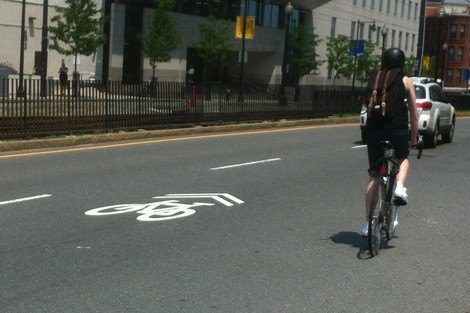June 26, 2013 — “Picture a bridge over a river with a hole in the middle,” said Dahianna Lopez, a PhD student in health policy at Harvard. “When people cross it, some are going to fall through the hole and into the water below. There will be people on the river bank who will jump in and pull them out one by one — those are the doctors. But the public health professionals will ask, ‘Hold on a second, why is there a hole in the bridge? How many people are falling through? How can we fix it?’”
Lopez is asking similar questions in her own research, as she works to shine a light on the factors that make it more likely for cyclists and pedestrians to be involved in a crash on the streets of Boston. She is earning her doctoral degree in health policy, with a concentration in evaluative science and statistics, through a University-wide interdisciplinary program offered through Harvard School of Public Health and five other schools and expects to graduate in 2016. She has received financial support for her work from the Boston Area Research Initiative at the Radcliffe Institute and the Rappaport Institute at the Kennedy School.
For the past year, Lopez has worked with Boston’s Police Department, Department of Transportation, and Mayor’s Office on an assessment of bicyclist injuries in the city. Findings from an analysis she led of narrative police reports of bicycle crashes was part of the Boston Cyclist Safety Report released by the Mayor’s Office in May 2013. With the help of Harvard’s Institute for Quantitative Social Science, Lopez also developed a methodology for automating the removal of personal identifiers from thousands of police narratives, which may help reduce a barrier to sharing sensitive data with other stakeholders.
Key findings from the report include:
- Collisions were dispersed all over the city (unlike street violence events, which are concentrated in certain parts of the city).
- Motor vehicles were involved in over 90% of the bicycle collisions reported to the Boston police.
- Taxis were more likely than non-taxis to “door” (open a door in the path of) an oncoming bicyclist.
- College-aged men were overrepresented in the crash reports, indicating that they are a population to target for prevention efforts.
Lopez’s section of the report also elucidated two areas in which policy makers could focus their efforts to address bike safety in Boston: hotspots and door-related injuries. Lopez identified the top five spots in each of Boston’s neighborhoods for cyclist injuries, including the portion of South Huntington Avenue directly across from the Back of the Hill stop of the trolley’s E line. Seven cyclists were injured at this location over a period of four years. Through analysis of the narrative police reports of these crashes, Lopez and her colleagues found that all but one could be attributed to a cyclist getting his or her wheel lodged in the trolley tracks. And crashes throughout the city could be reduced by 10% if drivers and their passengers were educated to look over their shoulder for cyclists before opening a car door, Lopez said.
Lopez expressed concern when, upon the report’s release, media coverage focused instead on whether helmets should be made mandatory for cyclists. “It’s not that helmets aren’t effective in preventing injury, it’s that they shouldn’t be our top priority right now,” she said. Returning to her analogy of the bridge, Lopez compared giving more cyclists helmets to throwing life preservers to the people in the water. Better to focus on preventing them from falling in the first place, she said.
She also emphasized that data regarding behavior responsible for a crash is incomplete. It is up to each individual officer whether or not to include factors such as if a cyclist ran a red light or was riding in a bike lane. Her goal was not to use the data to place blame on drivers or bicyclists, but to highlight the need for a more comprehensive data collection system that could uniformly capture elements that contributed to such collisions, she said.
Lopez hopes that future researchers will have more data to work with when attempting to measure the effectiveness of transportation safety interventions. The need for more data also was the motivation behind the Bicycle Analysis Reporting System, a project proposed by the winners of this year’s HSPH Spring Challenge student policy writing completion. The winning team, which was advised by Lopez who was also a judge, presented their proposal to Boston City Council in May.
Lopez believes that a data-sharing system such as that proposed by the students is feasible in Boston if political will could be harnessed. Based on her work in San Francisco, she strongly encourages the city of Boston to build a comprehensive injury surveillance system that links police and trauma center data. This system would also include crashes involving pedestrians, who are hit by cars far more often than bicyclists, she said.
“Pedestrian crashes are often forgotten,” Lopez said. “There is an identity specific to owning a bike. But not to being a pedestrian. That’s everyone.”
Lopez will give an oral presentation of more in-depth research findings at this year’s American Public Health Association conference, which will be held in Boston in November. This summer she is working for the National Highway Traffic Safety Administration and learning about how national transportation policies and funding streams impact injury prevention efforts and their outcomes.
Photo: Amy Roeder
